Only big guns. Armament and tactics of the XNUMXth century sailing fleet
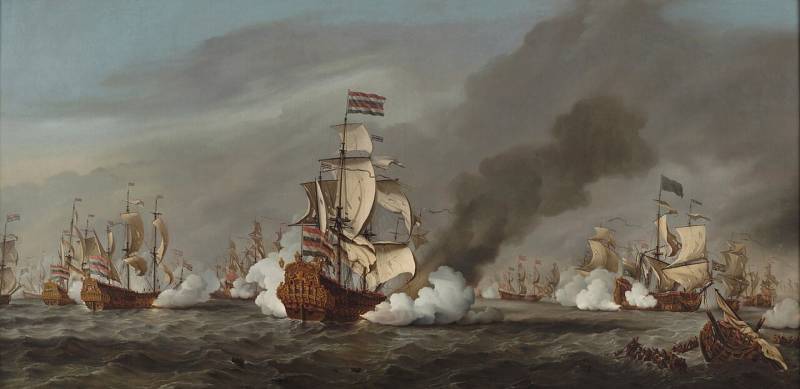
Lessons from the Invincible Armada
So, in the XNUMXth century, two main naval battles can be considered - Lepanto and a series of battles in England. fleet with the Invincible Armada. Since we are talking about the sailing fleet, let's talk about the Armada.
From July 31 to August 8, a chain of skirmishes occurred between the English and Spanish fleets. The British, at the instigation of the naval treasurer John Hawkins, spent the entire decade before the battle nurturing the idea of medium-range artillery combat, which would help them neutralize Spanish boarding tactics in battle. And what happened in the end?
Despite the shelling of the British, the Spaniards passed the canal like a knife through butter, and in the decisive battle of Gravelines, the English ships were unable to sink anyone.
This is not surprising, if you use the statistics given in the book “Armada Guns” by Michael Lewis. If we do not take into account small-caliber guns, the distribution of guns among the fleets was as follows:

If we consider the weight parameter of the broadside, then for the Spaniards it is 19 pounds, while for the British it is only 369 pounds, or 14 percent less than the Spanish.
So, given these statistics, nothing unusual happened - the English fleet was simply under-armed for its concept. However, understanding of this fact came only 50 years later, in the 1630s.
"I love bloody combat..."
Just in 1630, Lord High Admiral of England Algeron Percy, Earl of Northumberland, in an explanatory note to King Charles I, proposed creatively reworking Hawkins’ idea and, in accordance with this, working out the tactics of the English fleet.
Northumberland suggested relying on big guns and close combat. The tragedy of Hawkins, the count wrote, was that his ships were fired from medium and long distances with medium-caliber guns, so he simply could not inflict significant losses on the Spaniards, and a lot of ammunition was wasted.
Northumberland proposed arming the ships as strongly as possible and with as large cannons as possible, while the ships had to seek close combat, boldly approach the enemy - but not for boarding, but to bring down a hail of cannonballs on the enemy from a lethal distance.
The Lord High Admiral called this tactic in the French manner - melee (“cutting, fighting” is how knights in the Middle Ages called close combat).
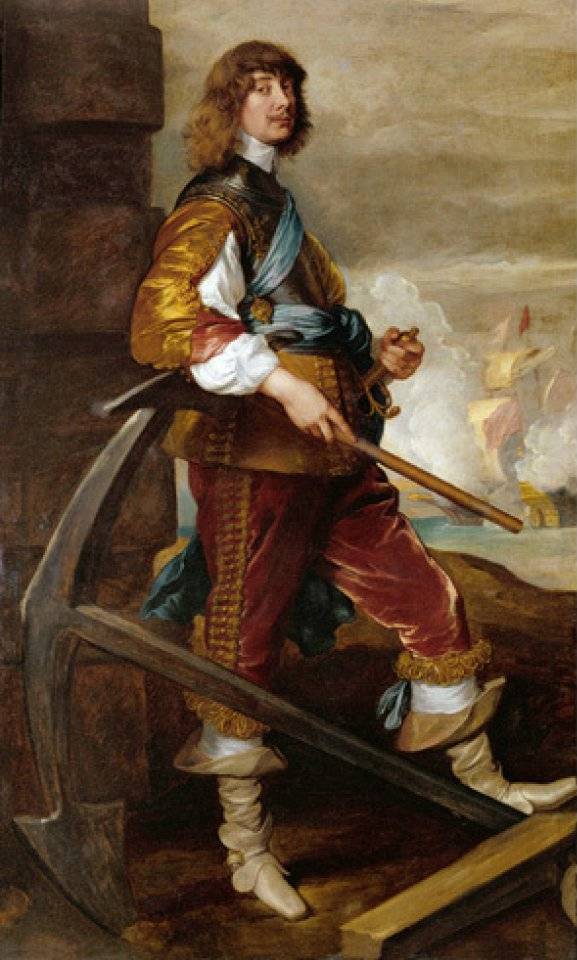
To implement this concept, under Charles I, lightweight large-caliber cannons - “drakes”, shorter and with rather thin walls, were introduced into the naval artillery, and the charge was reduced to two-thirds compared to the usual one. As a result, the muzzle velocity of the cannonball dropped from 1 feet per second to 300 feet per second. Cannonballs from such guns at close range did not penetrate, but broke through the sides of enemy ships, which led to a whole cloud of wood chips and hull fragments that wounded and maimed the enemy’s servants and crew.
The guns were placed on the English ships until there was 1 yard (slightly less than a meter) left between the lower gun ports and the water level. The guns were divided into large (calibers 64, 42 and 32 pounds), medium (18 and 12 pounds) and small (5 pounds and below).
When approaching, long medium-caliber guns began the battle, but in close combat large and small guns came into play. The task of large guns is to inflict as much damage as possible on the enemy; small guns demolished the enemy crew and gunners from the upper deck. Northumberland rejected the boarding tactics irrevocably, since, as he wrote to the king, the British would never be able to compare in their fighting qualities with the Spanish or Dutch marines.
As for the guns.
By the 64s, 1630-pound cannons were no longer produced; their remains were converted into stone throwers, which fired stone cannonballs weighing 24 pounds. Almost all of the fleet's 42-pounder guns (the so-called canon-royals) were mounted on the flagship Royal Sovereign. Therefore, the 32-pounder became the basis for heavy guns.
Dutch experience
As it turned out, all three fleets involved in the canal skirmishes in 1588 drew different conclusions. We have already talked about the conclusions of the British.
The Spaniards, on the contrary, decided that their galleons were quite durable and well-armed ships, which were a tough nut to crack for any enemy.
What about the Dutch?
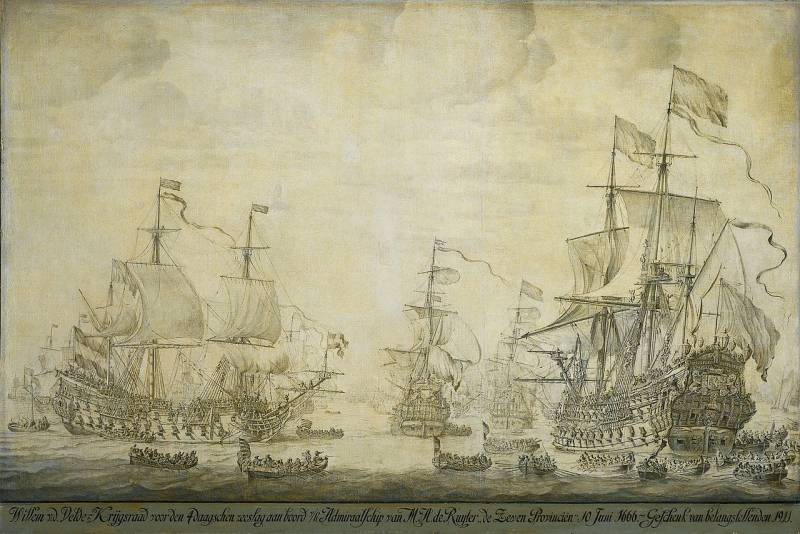
The Dutch made their own conclusions. They decided that it made sense to load their light ships even more with light artillery and use them in threes or fives against the lonely Spanish leviathans. Three or five ships would attack the Spaniard from several sides, knock out his crew with cannons, and then all the ships would board, overwhelming him with their numbers.
This tactic was directly borrowed from galleys and was called swarm tactics. And in principle, throughout the Eighty Years’ War, this tactic worked quite well against the Spaniards.
With the beginning of the Anglo-Dutch wars, the Dutch began to act “according to the manual,” but then they began to have problems over and over again. The fact is that the English ships turned out to be much better armed than the Spaniards, and their formidable artillery simply demolished the boarding teams with fire.
The Netherlands lost the first Anglo-Dutch war outright. Around this same time, the English “naval generals” - John Monck, Robert Blake and Anthony Dean - decided to rethink the experience of recent battles and, in fact, develop the tactics proposed by Northumberland.
The first to express a simple and brilliant idea was Anthony Dean, a former artilleryman: since the ship has guns located on the sides, therefore the most ideal formation of ships in battle is a line. It is in this case that the maximum possible number of ship guns will be used.
Actually, this was the beginning of linear tactics.
Lowestoft
Ironically, Dean's idea was far from new.
The first widely known battle fought by a European fleet in line was Vasco da Gama's battle with the Egyptian-Indians at Malabar in 1502. In 1583, near the island of San Miguel, the Spanish admiral Don Alonso de Bazan staged “Trafalgar in reverse” for the Anglo-French squadron, meeting it in the battle line and completely defeating it. In 1628, in the battle of Abrolhos Island, the Dutch and the Spanish-Portuguese - both opponents acted in line.
The battles in the Strait of Hormuz in 1624–1630 between the Spaniards and Portuguese with the Anglo-Dutch - both opponents tried to hold the column. During the Thirty Years' War, Dutch Admiral Maarten Tromp shared his thoughts on the advantage of fighting in line with British Admiral Pennington. But for the time being, the fleets did not fight in line.
The British first tried new linear tactics at the Battle of Lowestoft in 1665. It was before this battle that the commander of the fleet, the Duke of York, issued instructions "On the best construction of His Majesty's fleet". It indicated “strive with all our might to form a battle line”, and it was noted that "no ship of His Majesty's fleet shall pursue any small group of ships until the bulk of the enemy's fleet has been suppressed or put to flight". A separate point was the requirement "keep 100 yards between matelots". Each ship received a clearly defined place in the line.
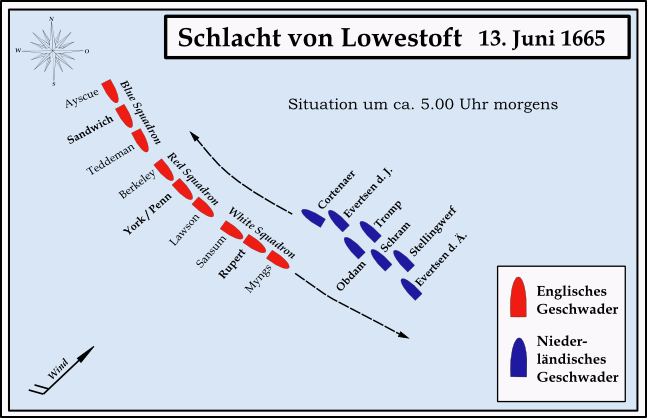
In turn, the Dutch, due to political differences, went into battle in as many as seven squadrons, the number of admiralties. Since at the initial stage the British held the line, they were able to easily repel the scattered attack of seven enemy squadrons, since the Dutch ships simply interfered with each other, often blocking the firing direction of their own ships.
Some of the Dutch ships were hired merchant ships, slow-moving armed ships, and this further aggravated the situation, and the British, when approaching, were able to devastate the decks of the Dutch with longitudinal salvos.
When the battle entered the melee phase, the position of the Dutch became completely unenviable. Due to the difference in armament, the British had a decisive advantage; the Dutch flagship Eendracht took off, killing commander-in-chief Jacob van Opdam. The loss of the flagship threw the Dutch into confusion; many of the ships turned 180 degrees and fell into the wind. The Dutch decided to withdraw from the battle, but, being disunited and not seeing orders from the commander, each detachment acted in its own way.
In total, the Dutch lost 19 ships of various ranks in this battle. It was a real rout. Perhaps the only thing that saved the Dutch was that many of the British ships were also merchant ships, hired for the campaign. Their captains had only a vague idea of discipline and military maneuvers, so they managed to hold the line only at the beginning of the battle, then the entire battle broke up into battles between individual ships. In this situation, some of the Dutch ships got a chance to escape.
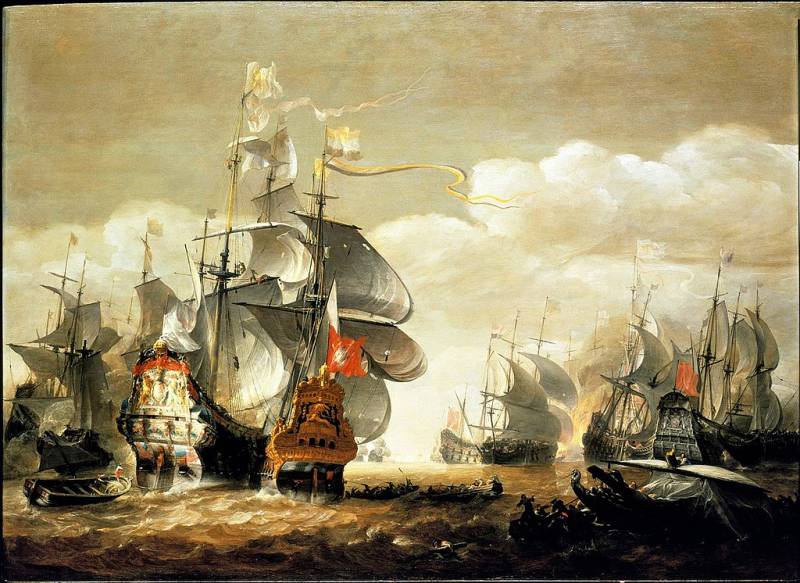
Individual ships, or even entire divisions, cut back and forth through the enemy line several times, the battle constantly broke up into several separate battles, mutual understanding between the vanguard, center and rearguard was very often simply lost, the cannon smoke that obscured the battlefield made not only orders invisible fleet commander, but also squadron commanders.
Some conclusions
It is clear that after the battle the Dutch decided to work on the mistakes. Among the reasons why such a defeat became possible were the small size and armament of the Dutch ships, and political squabbles in the States General, where deputies wanted to rule everything, including the fleet.
But still, the main problem was recognized as organization. Vice-Admiral Zealand Jan Evertsen noted that swarm and boarding tactics were outdated; at Lowestoft, several of his ships instinctively lined up to repel the British attack, and the enemy was eventually repulsed. On the other hand, during the entire battle, only one Dutch ship was successful in boarding; all the others failed and were either sunk or captured.
At the same time, the same Evertsen said - yes, the British have large-caliber guns on rank 24 ships, but they are mostly thin-walled, designed for close ranges. It is necessary to arm the Dutch ships with 18- and XNUMX-pounder cannons, but long ones with greater range and accuracy. The advantage of small-caliber guns is a faster loading time; therefore, when approaching, a Dutch ship will be able to release a greater weight of metal at the enemy than it will receive in response.
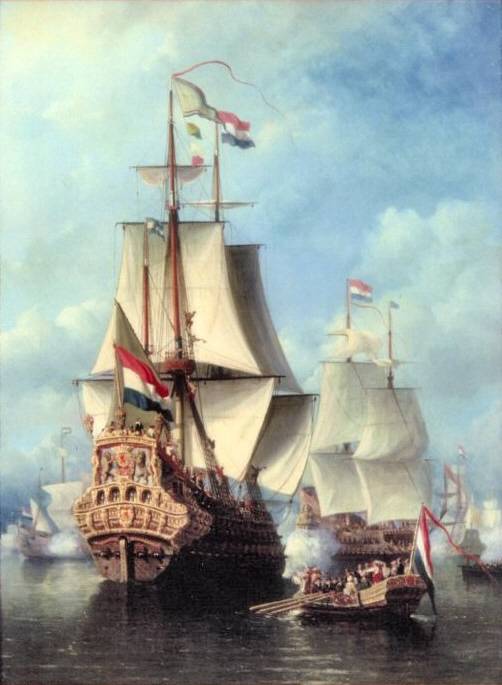
And just from 1666, the workhorse of the Dutch fleet became 70-gunners with 24-pounder guns on the lower deck. The only exceptions were flagship ships, for example, the 80-gun De Zeven Provinciën carried twelve 36-pounder and twelve 24-pounder guns on her lower deck. In general, it was the Dutch 24-pounders, due to their high rate of fire and rather significant caliber, that became an unpleasant surprise for the British.
On August 15, 1665, Grand Pensioner Jan de Witt issued instructions to the fleet ordering battle in the wake line. Bearing in mind the consequences of Obdam's death at Lowestoft, they made a separate addition - so that squadron commanders would not die so quickly in the future, their middle divisions should be slightly pulled back in battle, relative to the vanguard and rearguard (of each squadron), that is, the line should have a snake-like shape (slangvormige). This provision remained law for a long time in the Netherlands, but the admirals did not pay any attention to it.

Now the fleet was always formed into three squadrons (vanguard, center and rearguard). In 1666, Admiral Michael de Ruyter, at the instigation of Jan de Witt, decided to create a fourth squadron - a reserve. The idea seemed quite successful: in the event of a battle with superior forces, the reserve was poured into one of three detachments, but in a battle against smaller forces, it could attack the enemy from the rear, or put it in two fires.
And from the same 1666, the practice of exercises was introduced in the English and Dutch fleets, which allowed captains and sailors to learn to hold the line and fight in the line.
It was from this time that linear tactics finally came to the fleet, and the first regular fleets appeared in the world.
References:
1. John Clerck of Eldin “Essay on Naval Tactics” – 1779.
2. Spencer C. Tucker “Naval Warfire” – “Sutton Publishing”, Phoenix, 2000.
3. James J. Tritten “Doctrine and Fleet Tactics in the Royal Navy” - Norflock, 1994.
4. Fox, Frank, “Great Ships: the Battle fleet of King Charles II” – Greenwich, 1980.
5. Fox, Frank, “A Distant Storm, the Four Days Battle of 1666,” Press of Sail Publications – Porterfield, 1996.
6. Grove, G.L., “Journaling van de Admirable Van Wassenaer-Obdam (1658/59) en De Ruyter (1659–1660)” – Amsterdam, 1907.
7. Howard, Dr. Frank, "Sailing Ships of War, 1400–1860" - Greenwich, 1979.
8. Brandt, Gerard, “Het Leven en Bedryf van den Heere Michiel De Ruiter, Wolfgang, Waasberge, Boom, van Someren en Goethals” – Amsterdam, 1687.
Information